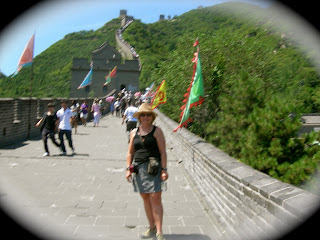BEIJING
August in Beijing, not my idea of fun. Actually Beijing is not my idea of fun. Beijing outgrew its infrastructure about 20 million people ago. The roads are congested, the air is polluted. It is now the capital of China, so an important city, and the Great Wall needed to be climbed, the Forbidden City needed to be explored and Tiananmen Square needed to be visited.
My guide in Beijing was a 25-year old Chinese girl from "Inner Mongolia" named Alice
. We began our sightseeing with the Great Wall, or I should say the portion nearest Beijing since the Great Wall is around 5500 miles in length (according to Wikipedia) and sections were begun in the 7th C. BC. It is an awesome sight and the long, hot climb (steps) took over an hour but provided
breathtaking views from the top with glimpses of other portions of the wall trailing off the horizon.
breathtaking views from the top with glimpses of other portions of the wall trailing off the horizon.
The Forbidden City was beautiful but crowded and a bit dirty. It is hard to keep an historic site pristine with hundreds of thousands of people milling around weekly. This seems surprising in retrospect, as it doesn't fit my preconceived notions about the Chinese.


My guide then took me to Tiananmen Square where armed guards stand about, I guess to make sure that nothing happens like what happened back in 1989. As we walked around the Square I asked my guide, Alice, about the student uprising of 1989, and she was shocked to know that I had heard about it as there is no information available in China concerning what the West calls the "Tiananmen Square massacre." There is total suppression of this information in China, so today no one knows for sure if the number of dead was in the hundreds or the thousands.
I had planned to fly to Tibet from Beijing. When I asked Alice to assist me in getting to Tibet she said, "Oh, Chinese Tibet." Hard to argue about that with a Chinese person. Turned out that Tibet had been closed for the month of July to any outsiders because of the anniversary of the Chinese take-over, so my visitor's pass had not been taken care of in a timely manner and there was no way for me to get to Tibet. That bummed me out as I have wanted to visit Nepal and Tibet since I was a child. Maybe there will be another chance down the road.
Beijing was not one of my favorite places, although I am always interested in seeing and experiencing other cultures and countries. It was educational and that sometimes has to be enough. You probably could attribute my lack of true appreciation of Beijing to my preference for nature, adventure, and kayaking!
 |
| Birds Nest from the Olympics |
Beijing was not one of my favorite places, although I am always interested in seeing and experiencing other cultures and countries. It was educational and that sometimes has to be enough. You probably could attribute my lack of true appreciation of Beijing to my preference for nature, adventure, and kayaking!











































